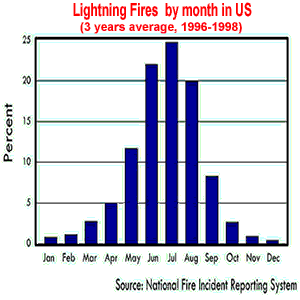|
4st PART
When lightning occurs, electrical discharges produce a very high temperature, then the air expands violently by giving it strong vibrations. This expansion creates a shock wave and causes as explosion, thunder. The latter can sometimes be heard up to 20 km when the thunderstorm is very violent. When the lightning is straight and short, the waves produced are heard as a single thunderclap. But when it is long and forks, we hear a succession of rumbles. How to calculate the distance of a thunderstorm ? Light moves at fantastic speed of 300.000 km/s. Therefore just lightning produces its light, a fraction of a second after we see it so immediately. But sound, slower than light, moves to 337 m/s or 1 million times more slowly. It is therefore possible to determine the distance from the thunderstorm. To this we must multiply the elapsed time between lightning and thunder by 337 to determine the distance in meters or divide by 3 to approximately know its distance in kilometres. Exemple : If you hear thunder 6 seconds after seeing the flash then the thunderstorm is located at 2.022 metres of us is about 2 km (337.x.6 = 2.022 meters or 6/3 = 2 km). Severe thunderstorms are usually accompanied by hail which destroy entire crops, including grapes on foot, damaging roofs or windshields of cars. Each year it is responsible for tens of thousands of disasters, declared insurance amounting to several million Euros in France and the USA more. In 1981 a shower of hail caused damage of 100 millions dollars in 15 minutes. They are often accompanied by violent gusts of winds that can become dangerous. On 07/16/2003, in France, violent thunderstorms kicked up along the Atlantic coast with gusts of wind of 158 km/h in the Landes, Gironde, Pays de la Loire which has uprooted full of trees, overturned caravan in campgrounds. In USA it is possible that sometimes tornadoes form during severe thunderstorms. During thunderstorms it is possible that forest fires are ignited by a lightning. When it hits a tree, the fire almost always lights because lightning emit a lot of energy. If this thunderstorm is accompanied by gusts of wind that can cause damage because the flames will spread quickly so many hectares will be burned. In Canada, 20% of forest fires are caused by lightning, and the majority occur during the months of June and July. Lightning is also responsible for about 2000 fires that occur on private property. France 5% fires are caused by lightning.
Rainfalls are often very intense which can cause flooding or mudslides as was the case the 07/05/2000 with violent thunderstorms that broke out in Normandy and caused flooding and mudslides in Seine-Maritime and Calvados. The lightning that reaches the ground represents only 10% of the number of lightnings. Contrary to what some think, lightning can strike several times in the same place. The french ground is struck by 1 million impacts on average each year. During a thunderstorm it is important not to sheltered under a tree. Lightning occurs not only by the thunder and lightning, but also by overpressure, shock waves, electromagnetic waves and magnetization of certain minerals. Discharge currents vary from several thousand to several hundred thousand amperes. On living beings, they cause electrocution and significant burns. It is possible that even wet clothes receive most of the discharge and be volatilized without the body is reached. In Canada, lightning kills on average 16 peoples per year on nearly 100 strucks by lightning.
Lightning is a natural phenomenon that could pollute the
atmosphere. It produces nitrogen oxide, a greenhouse gas that
accumulates in the upper part of the atmosphere. According
to an U.S. study lightning could be the cause of the overload
of nitrogen oxide in the atmosphere in the northern hemisphere
compared to the southern hemisphere. This would be due by
the northern hemisphere consists of more continental land
than the southern hemisphere and summer lightning falls mainly
on continental parties. These are the high temperatures
of the lightning that transform oxygen and nitrogen molecules
in nitrous oxide molecule.
If you are outside : - you must keep away from large objects such as trees and telephone poles ; - you should avoid being in a landscape. It is best to seek shelter in a low-lying area as a valley ; - it is especially important be away from the water which is a good conductor of electricity. Don't swim or leave by boat when a thunderstorm is coming and if you are already on a boat or in the water you have to go as quickly as possible on the land ; - must move away from objects that are good conductors of electricity such as tractors, stick golf, metal fences, motorcycles, lawnmowers and bicycles (don't play golf, take an umbrella or fishing line) ; - during a thunderstorm you are safe inside a car, but don't touch the metal parts. You mustn't park near trees or other objects high that can topple over during a thunderstorm and you must pay attention to the electrical lines that have fallen or could fall on your car ; - if you are in a forest, you must take shelter under dense vegetation formed of small trees or bushes ;
If you are indoors : - don't go out ; - you must be away from doors or windows and any objects which are conductors of electricity such as radiators, stoves, sinks, pipes and metallic pipes ; - il ne faut pas se servir de matériel électrique et téléphonique ; - before the thunderstorm is near you, unplug electrical appliances, including radios and televisions. But don't touch during the thunderstorm ;
WARNING |





